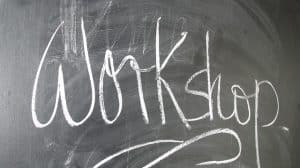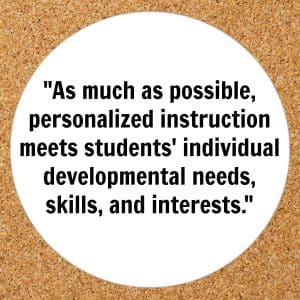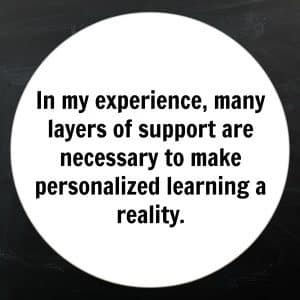A Close-Up Look at How a Workshop Framework Can Enhance Personalized Learning
CompetencyWorks Blog
 When I started teaching first grade over twenty-five years ago, I quickly realized that I was going to need additional strategies and support in order to help each of my students become independent readers and writers. The research and work of Donald Graves had a profound impact on my teaching as a young educator. I can remember reading Writing: Teachers and Children at Work (Graves, 1983) and falling in love with the workshop approach. This was the kind of supportive, communal learning experience I wanted to replicate for my students.
When I started teaching first grade over twenty-five years ago, I quickly realized that I was going to need additional strategies and support in order to help each of my students become independent readers and writers. The research and work of Donald Graves had a profound impact on my teaching as a young educator. I can remember reading Writing: Teachers and Children at Work (Graves, 1983) and falling in love with the workshop approach. This was the kind of supportive, communal learning experience I wanted to replicate for my students.
It was this revolutionary research and work of Donald Graves and his colleagues Lucy Calkins (Calkins, 1986) and Mary Ellen Giacobbe (Giacobbe, 2006) that supported my early years of teaching. Donald Graves taught me how to create a safe space for children to use their voices to tell their individual stories through speaking, listening, drawing, and writing. This philosophy of personalization enabled me to really listen to my student writers and allow them to show me what they needed next for instruction.
Fast forward to 2008 when I found myself working as an Instructional Strategist in RSU #57 in southern Maine. Conversations were beginning in Maine about WHY we needed to transform teaching and learning in the twenty-first century. I listened to Tony Wagner, Co-director of the Change Leadership Group at the Harvard Graduate School of Education, speak at an ASCD conference about his research. His research findings presented a strong case for reimagining our school systems and teaching the 7 Survival Skills of -21st Century Students to prepare students for college and careers in a new global economy.
My school district embraced this effort and hired coaches from the Reinventing Schools organization to guide us. Staff began to wrap their heads around the concept of “learning is the constant, time is the variable.” We were encouraged to start growing a personalized, proficiency-based learning model in our classrooms. What this would look like in practice became a focus of our collaborative conversations and work.
 We spent time developing a culture of learning and working with our students to unpack our essential standards and rewrite them in kid-friendly language. As we made the learning transparent to our learners, we recognized the need to employ predictable, yet flexible class structures that would offer varied opportunities for students to work at their own pace. Learners moving through personalized pathways toward proficiency of essential standards seemed to be a lofty goal to achieve.
We spent time developing a culture of learning and working with our students to unpack our essential standards and rewrite them in kid-friendly language. As we made the learning transparent to our learners, we recognized the need to employ predictable, yet flexible class structures that would offer varied opportunities for students to work at their own pace. Learners moving through personalized pathways toward proficiency of essential standards seemed to be a lofty goal to achieve.
I began to reflect deeply on all that I had learned and implemented from Donald Graves’ work and it suddenly occurred to me. I wondered: could the workshop instructional framework serve as a necessary structure for our redesigned and more personalized system?
Teachers were already using the traditional literacy workshop framework with children in many of the elementary classrooms at my school. Based on formative assessment data, teachers provided a workshop model that included a daily minilesson – a short lesson that included a specific teaching point and some type of modeling or demonstration, time given for guided and independent practice, and time to reflect and share as a community of learners.
As we embraced a personalized learning approach, teachers released that control to their students. And so, our teachers invited students to take a more active role in choosing what learning content they needed, as well as how they would experience or practice the learning on a given day. They masterfully expanded and modified the familiar workshop instructional practices to other content areas, such as math, science, and social studies. The results were as astonishing as they were immediate. Our students became more engaged in their learning. As I worked in classrooms, children would eagerly show me pieces of evidence to explain their learning progress.
The predictable format of a workshop allows an entry point for our learners of all ages and stages of development. In using a workshop model as part of our personalized learning initiative, our students could articulate exactly where they were as learners, without fear of being compared to other learners in the class. Classroom community cultures began to change and students helped each other through learning challenges.
In classrooms where a workshop model was already established, the shift to personalized learning was a natural next step for both staff and students. Just as children are motivated to read and write when given the time, choice, and supportive structure to do so, we found the workshop model of instruction to lend itself well to students working at their own pace in a proficiency-based learning system across a variety of content areas.
 This work has continued for me as I moved to an Instructional Coaching position for the Biddeford School Department in southern Maine. Our district is in its third year of providing resources to support the implementation of student-centered learning practices. We have worked with a Reinventing Schools’ coach and are currently exploring the Students at the Center Framework. The tenets of this framework include: Learning Is Personalized, Learning Is Competency-Based, Learning Takes Place Anytime, Anywhere, and Students Have Agency and Ownership Over Their Learning. (Students at the Center, Jobs for the Future, 2016.
This work has continued for me as I moved to an Instructional Coaching position for the Biddeford School Department in southern Maine. Our district is in its third year of providing resources to support the implementation of student-centered learning practices. We have worked with a Reinventing Schools’ coach and are currently exploring the Students at the Center Framework. The tenets of this framework include: Learning Is Personalized, Learning Is Competency-Based, Learning Takes Place Anytime, Anywhere, and Students Have Agency and Ownership Over Their Learning. (Students at the Center, Jobs for the Future, 2016.
Specifically, the Students at the Center Framework states, “As much as possible, personalized instruction meets students’ individual developmental needs, skills, and interests.” At Biddeford Middle School, one of our current school improvement goals states that all BMS classrooms will foster personalized learning that ensures student voice and choice through the use of varied instructional strategies where teachers engage in innovation and exploration of new strategies.
Many of our teachers have started to explore and implement a flexible workshop framework to provide a structure that helps increase personalized learning for students. This structure empowers our students to work at their own pace and make choices in their learning pathways toward proficiency. For example, our math department has experimented with a variety of ways to offer minilessons when students need to learn a specific skill. But these aren’t the short-duration, direct instruction demonstrations delivered to a large group at one time.
Rather, in our student-centered learning model, students may choose to participate in a minilesson based on a skill or learning target that they need to learn. Often, our students will meet for a small group minilesson with a teacher. Our math coach, Linda Descoteaux, explains that sometimes minilessons will happen naturally as students find themselves with questions or unable to move on to their next learning target. “They’ll often seek each other out for help or to ask a question.” As our students collaborate to seek understanding, we see evidence that our students are truly invested in their learning.
Some of our teachers have added a blended learning component to customize their workshop framework. Through the use of video tutorials made by the teacher, minilessons can be watched individually. Through technology tools such as Google Classroom and Edmodo, students who have been absent, are moving at a faster pace, or are in need of some re-teaching can view the online video minilessons anywhere, anytime. These modules have been well received by our students. Students have reported that they like hearing their own teacher’s voice in the online minilesson rather than that of a commercialized video.
We continually reflect on our progress toward personalized learning for our students. A next step that would allow for greater student involvement in the learning process would be for our students to create online minilessons for their peers. This would enable students to apply their learning to create something new. John Hattie (Hattie, 2016) describes this as transfer of learning, which is our ultimate goal for students. In the book, Visible Learning for Literacy, authors Fisher, Frey, and Hattie state, “A close association between a previously learned task and a novel situation is necessary for promoting transfer of learning.” I’d love to see a student take a skill that had been challenging to learn and then problem-solve and create a new way for peers to understand the same concept.
The heart of the workshop in any content area remains the pedagogic methods of guided practice and independent practice with time for teachers to confer with students and offer specific feedback. In a traditional workshop, the teacher is often the sole keeper of the formative assessment data, such as conferring notes and work samples. But, in a personalized learning environment, students also keep track of their individual learning progress. As students progress through their learning targets, they recognize they are one step closer to becoming proficient with their essential standard.
Our staff has created a variety of learner tracking tools, such as student goal sheets, learning target checklists, capacity matrices, audio feedback, digital photos, and e-portfolios. Our district follows Robert Marzano’s (Marzano, 2007) instructional and assessment framework and we incorporate this information when creating learner tracking tools.
Choice in selecting the right learner tracking tool can be a motivational factor for our middle schoolers. In talking with students, we have found that some prefer a checklist for its simplistic, linear format, while others prefer the visual of a capacity matrix with space to write comments. Our staff is continually seeking input from students to offer a variety of tools that best meet the needs of individual learners in their classrooms
Self-reflection as a form of assessment is becoming a more widely used practice in our middle school classrooms. This important component allows the learner to pause and consider what (s)he needs next and enables the learner to have control over his/her learning experiences. Many of the students I have spoken to about their use of self-reflection say that they feel a sense of pride in knowing that they are learning skills and making progress toward meeting their academic standards or their performance expectations (Habits of Work and Learning).
 Does the shift to personalized learning happen overnight? It cannot and most likely would not be sustainable if implemented too quickly. In my experience, many layers of support are necessary to make personalized learning a reality. I am extremely fortunate to work in district committed to this important work. At my school, Principal Kyle Keenan encourages our staff to experiment and take small steps to increase personalization in their classrooms. He understands that the paradigm shift from a time based system to a learning/performance based system is a process and will evolve over time.
Does the shift to personalized learning happen overnight? It cannot and most likely would not be sustainable if implemented too quickly. In my experience, many layers of support are necessary to make personalized learning a reality. I am extremely fortunate to work in district committed to this important work. At my school, Principal Kyle Keenan encourages our staff to experiment and take small steps to increase personalization in their classrooms. He understands that the paradigm shift from a time based system to a learning/performance based system is a process and will evolve over time.
Staff support structures include instructional coaching cycles and time for staff to work together in content area PLC’s and team meetings. In an effort to build internal capacity to sustain this work, our district recently started a new peer coaching initiative. Twenty-five teachers stepped up to receive additional training in student-centered learning practices and peer coaching.
Their work includes time to learn and reflect together about student-centered learning, as well as peer coaching training. Currently we are reading and discussing Peer Coaching by Pam Robbins (2015). Building leaders provide time within the school day for coaches to collaborate with and offer feedback and support to peers. This project will help accelerate our implementation of the student-centered learning components, including personalized learning.
In addition, we are now offering personalized professional learning sessions during our staff inservice and early release days at the middle school. By offering a recurring menu of professional learning sessions for staff to choose from, we are modeling the importance of the learner being in the driver’s seat with his/her learning. The staff feedback has been overwhelmingly positive with this approach to professional development. Many teachers have consistently said that they love having choice in how and what to learn during these sessions, as well as time to collaborate with colleagues in other grade levels and departments.
It is our moral imperative to reflect individually and with colleagues to discuss how student-centered learning practices can be incorporated into today’s classrooms. By thinking about what is already working well within your existing classroom routines and structures and adapting some of those structures, you may be one step closer to creating a personalized learning environment. Each shift will support our learners in becoming the flexible thinkers and self-directed problem-solvers needed to succeed in college and future careers.
As new ideas and research are presented in education it is tempting to think we need to throw out all of the old to make room for the new. Revisiting my literacy roots and the work of my mentors reminded me to really listen to what our students are showing and telling us that they need as learners. Lessons learned from Donald Graves all those years ago continue to inspire my work in helping staff, students, families and community work together to design a customized learning experience for each child.
References:
Calkins, L. (1986). The Art of Teaching Writing. Portsmouth, NH: Heinemann.
Graves, D. H. (1983). Writing: Teachers and children at work. Portsmouth, NH: Heinemann.
Fisher, D., Frey N, Hattie, J. (2016). Visible Learning for Literacy. Thousand Oaks, CA: Corwin.
Horn, Martha & Giocobbe, Mary Ellen. (2006). Talking, Drawing, Writing. Portland, ME: Stenhouse.
Marzano, Robert J. (2007). The Art and Science of Teaching: A Comprehensive Framework for Effective Instruction. Alexandria, VA: ASCD.
Robbins, Pam. (2015). Peer Coaching to Enrich Professional Practice, School Culture, and Student Learning. Alexandria, VA: ASCD.
Wagner, Tony. (2008). The Global Achievement Gap. New York, NY: Basic Books.
Mary Bellavance is Co-President of Maine ASCD. She is an Instructional Coach for the Biddeford School Department, Biddeford, Maine; a Students at the Center Distinguished Fellow; and a teacher-consultant for the Southern Maine Writing Project and National Writing Project. She enjoys connecting with educators via Twitter @MaryBellavance.